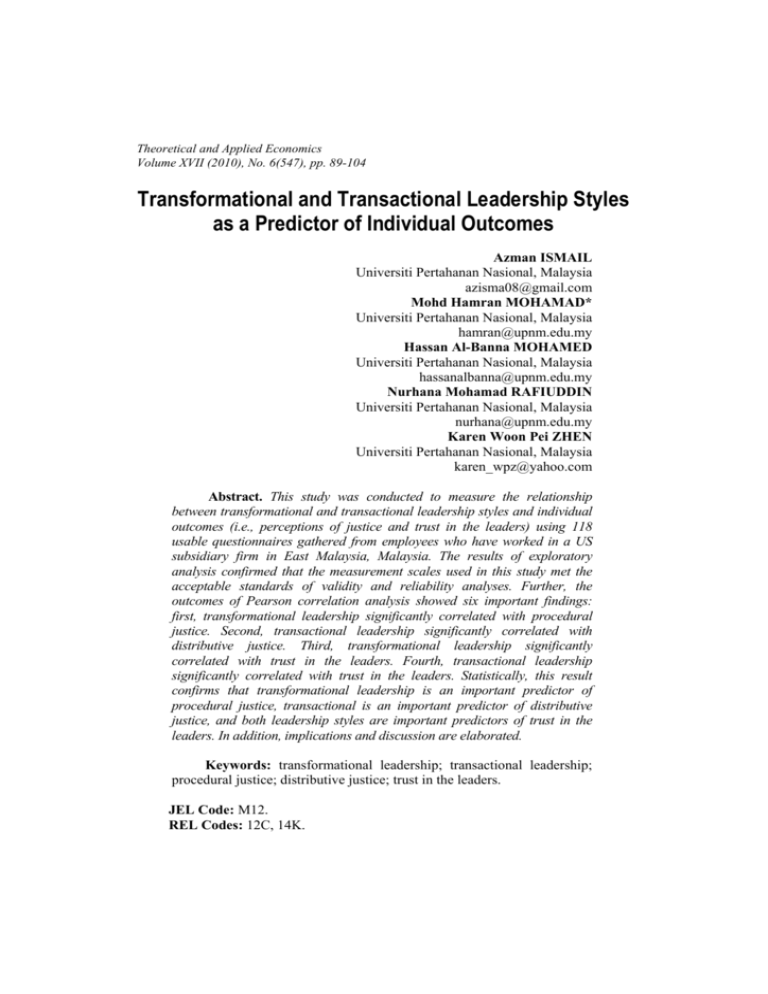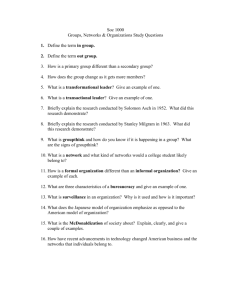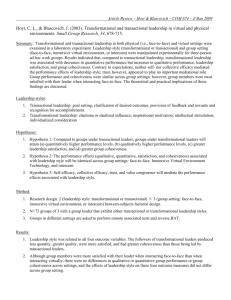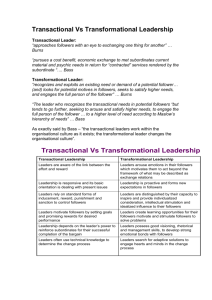Transformational and Transactional Leadership Styles as
advertisement

Theoretical and Applied Economics Volume XVII (2010), No. 6(547), pp. 89-104 Transformational and Transactional Leadership Styles as a Predictor of Individual Outcomes Azman ISMAIL Universiti Pertahanan Nasional, Malaysia azisma08@gmail.com Mohd Hamran MOHAMAD* Universiti Pertahanan Nasional, Malaysia hamran@upnm.edu.my Hassan Al-Banna MOHAMED Universiti Pertahanan Nasional, Malaysia hassanalbanna@upnm.edu.my Nurhana Mohamad RAFIUDDIN Universiti Pertahanan Nasional, Malaysia nurhana@upnm.edu.my Karen Woon Pei ZHEN Universiti Pertahanan Nasional, Malaysia karen_wpz@yahoo.com Abstract. This study was conducted to measure the relationship between transformational and transactional leadership styles and individual outcomes (i.e., perceptions of justice and trust in the leaders) using 118 usable questionnaires gathered from employees who have worked in a US subsidiary firm in East Malaysia, Malaysia. The results of exploratory analysis confirmed that the measurement scales used in this study met the acceptable standards of validity and reliability analyses. Further, the outcomes of Pearson correlation analysis showed six important findings: first, transformational leadership significantly correlated with procedural justice. Second, transactional leadership significantly correlated with distributive justice. Third, transformational leadership significantly correlated with trust in the leaders. Fourth, transactional leadership significantly correlated with trust in the leaders. Statistically, this result confirms that transformational leadership is an important predictor of procedural justice, transactional is an important predictor of distributive justice, and both leadership styles are important predictors of trust in the leaders. In addition, implications and discussion are elaborated. Keywords: transformational leadership; transactional leadership; procedural justice; distributive justice; trust in the leaders. JEL Code: M12. REL Codes: 12C, 14K. 90 A. Ismail, M. Hamran Mohamad, H. Al-Banna Mohamed, N. Mohamad Rafiuddin, K. Woon Pei Zhen 1. Introduction In the early studies of human resource development much describe on the characteristics of leadership behavior where it emphasizes more on the type of relationship between leaders and followers in organizations (Bass, Avolio, 1991, 1993, Howell, Avolio, 1993, Schriesheim et al., 1999). The type of such relationships can occur in two different forms: transformational leadership and transactional leadership (Burns, 1978, Bass, Avolio, 1991, 1993, MacKenzie et al., 2001, Rowold, 2008). Both leadership styles were first developed by Burns (1978) and this was expanded by Bass and Avolio (1991) to become the generic leadership model for dynamic organizations, which include four primary elements: first, individualized considerations is often viewed as leaders aware about employees concerns and developmental needs as well as providing the learning opportunities for them to grow in a supportive environment. Intellectual stimulations are usually seen as leaders develop followers’ innovation and creativity in managing their tasks and responsibilities. Followers are encouraged to question their own way of doing things and sideline outdated principles and practices. Inspirational motivations are related to leaders frequently articulate future goals of the organization which are perceived as meaningful and challenging to the work and personal goals of the followers. The followers are motivated and inspired by the goals of the organization. Idealized influence is often referred to leaders who are very determined, persistent and always emphasized achievement in their mission. They take personal responsibility and display high moral standards and behavior. As such, they are well respected and trusted by their followers (Bass, 1985, Bass, Avolio, 1991, 1993, Twigg et al., 2008). Transformational leadership concept is based on relational contract rather than on economic contract, where it takes the form of social exchange (subordinates obliged to their leaders and willing to contribute beyond the requirements of formal employment contracts), covenant (agreed commitment to the welfare of both parties to the exchange) and psychological contract, that is a set of beliefs held by a person regarding the terms of the exchange agreement to which that person is a party (Kanungo, Mendonca, 1996, MacKenzie et al., 2001, Rowold, 2008, Twigg et al., 2008). In this era of global competition, this leadership approach is often used to develop personality capabilities of leaders simply to create a positive transformational process, such as creating awareness amongst employees on the benefits of growth, importance of self-expression, motivation to perform at new and higher levels, encourage teaching and coaching which serves as a leverage for followers to perform beyond their expectations, changing their values and beliefs, and raising their Transformational and Transactional Leadership Styles as a Predictor of Individual Outcomes 91 hierarchy of needs (Bass, Avolio, 1993, Gillespie, Mann, 2004, Twigg et al., 2008, Howell, Avolio, 1993). Conversely, transactional leadership concept is based on economic contract, economic exchange or cost-benefit concept which is done in the short-term (MacKenzie et al., 2001, Rowold, 2008, Seltzer, Bass, 1990). Relying on an economic based transaction, transactional leadership concept is developed based on two primary factors: contingent reward approach (rewards are provided in exchange for meeting agreed upon objectives or the ability of followers to perform tasks based on their leaders’ wish) and management-by-exception (the leaders intervene when employees make mistakes by establishing visible mechanisms to implement proper rules) (Bass, Avolio, 1991, 1993, Howell, Avolio, 1993, Lowe et al., 1996, MacKenzie et al., 2001). In practice, transactional leadership is equally important as transformational leadership in order to help leaders increase organizational competitiveness in an era of global competition (Bass, Avolio, 1993, Howell, Avolio, 1993, Pillai et al., 1999). Surprisingly, recent studies using a wide variety of samples have shown that the ability of leaders to properly use transformational and transactional leadership styles may have a significant impact on individual outcomes, especially followers’ perceptions of justice (Greenberg, 1996, 2003, Tatum et al., 2003a, 2003b), and trust in the leaders (Konovsky, Pugh, 1994, Korsgaard et al., 1995, Pillai et al., 1999). Many scholars, such as Folger (1977), Brockner and Wiesenfeld (1996), Leventhal (1976, 1980), Leventhal et al. (1980), and Greenberg (1996, 2003), divide perceptions of justice in two major features: procedural justice and distributive justice. Procedural Justice is often defined as individuals perceive fairness about the process and systems used by their employers to allocate outcomes (e.g., rewards and recognition). While distributive justice is usually defined as individual’s sense of fairness about the outcomes (e.g., rewards and recognition) received from their employers (Brockner, Wiesenfeld, 1996, Folger, Greenberg, 1985, Folger, Konovsky, 1989, Konovsky, Pugh, 1994, Greenberg, 1996, 2003). Although, a linkage of transformational and transactional styles to perceptions of justice has been well established, but the effect of different leadership styles on procedural justice and distributive justice is given less attention in leadership research literature (Bass, 1990, Podsakoff et al., 1990, Schriesheim et al., 1999). Conversely, scholars like Fine and Holyfield, (1996), Bass (1990), Kramer and Isen (1994), Kramer and Tyler (1996), Mishra (1996), Lane and Bachmann (1998), and Gefen et al. (2008) conceptualize trust as a psychological state where an employee faith in and loyalty to the leaders, especially in the following aspects: can make good decisions and judgments, overcome obstacles, helpful, establish a cooperation between organizational members, good in leading followers when doing organizational projects, 92 A. Ismail, M. Hamran Mohamad, H. Al-Banna Mohamed, N. Mohamad Rafiuddin, K. Woon Pei Zhen provide correct information about the tasks, and give full commitment to organization (Cummings, Bromiley, 1996, Das, Teng, 1998, Fine, Holyfield, 1996, Podsakoff et al., 1990). In a leadership framework, several scholars think that that transformational leadership style, transactional leadership style, and trust in the leaders are distinct constructs, but highly interrelated (Bass, Avolio, 1993, Konovsky, Pugh, 1994, MacKenzie et al., 2001, Schriesheim et al., 1999). For example, transformational style is relied on social exchange (e.g., follower development) and transactional style is based on economic exchange (e.g., reward contingent job) in managing followers to achieve job targets. The ability of leaders to properly implement transformational style may strongly invoke perceptions of procedural justice, transactional style may strongly increase invoke perceptions of distributive justice, and both leadership styles may lead to higher trust in the leaders. Although this relationship is interesting, little is known about the effect of transformational and transactional justice on individual outcomes in organizational leadership literature (Gefen et al., 2008, Korsgaard et al., 1995, Pillai et al., 1999). Hence, it motivates the researchers to further explore the issue. 2. Objective of the study This study has four major objectives: first, to measure the relationship between transformational leadership and procedural justice. Second, to measure the relationship between transactional leadership and distributive justice. Third, to measure the relationship between transformational leadership and trust in the leaders. Fourth, to measure the relationship between transactional leadership and trust in the leaders. 3. Literature review Transformational leadership, transactional leadership and perceptions of justice Human resource development literature highlights that many scholars make interpretations about the relationship between leadership and perceptions of justice based on their observations and understanding about leadership behavior theory (Avolio et al., 1995, Bass, 1990, Howell, Avolio, 1993, Liangding et al., 2007, Schrieshem et al., 1999) and organizational justice theory (Folger, Konovsky, 1989, Konovsky, Pugh, 1994, Lind, Tyler, 1988, Tyler, Degoey, 1996). Outcomes of this study generally show that leaders who properly implementing both transformational and transactional leadership styles will strongly invoke followers’ perceptions of justice about the leadership styles Transformational and Transactional Leadership Styles as a Predictor of Individual Outcomes 93 (Alexander, Ruderman, 1987, Folger, Konovsky, 1989, Korsgaard et al., 1995, Lind, Tyler, 1988). Organization justice addresses two major theories: procedural justice theories and distributive justice theories (Folger, Cropanzano, 2001, Greenberg, 1996, 2003). Procedural justice theories emphasize on fairness about the process and systems and/or methods used to distribute outcomes or make decisions (Lind, Tyler, 1988, Tyler, Lind, 1992, Walker et al., 1979), such as consistency, bias suppression, accuracy, correct ability, ethicality, and representativeness (Leventhal, 1976,1980). Application of this theory in a leadership model shows that the ability of leaders to properly use transformational process in planning and administering jobs (e.g., clarity of policy and work process, communication openness, participation, and empowerment) tends to invoke followers’ perceptions of procedural justice in organizations (Korsgaard et al., 1995, Pillai et al., 1999). Distributive justice theories explain that fairness of outcomes will exist if employees perceive that they receive outcomes equitable with their contributions (Adams, 1963, 1965, Hegtvedt, Markovsky, 1995, Konovsky, Pugh, 1994, Thibaut, Walker, 1975), such as equity rule (recognize contribution), needs rule (promote personal welfare) and equality rule (preserve social harmony) (Leventhal, 1976, 1980, Leventhal et al., 1980). Application of this theory in leadership model shows that the ability of leaders to properly use transactional process in planning and administering jobs (e.g., no discrimination, obey to work regulation, adequacy of reward, and warning when mistakes are made) will invoke followers’ perceptions of distributive justice in organizations (Gefen et al., 2008, Korsgaard et al., 1995, Pillai et al., 1999). Transformational leadership, transactional leadership and trust in the leaders Many previous studies on organizational leadership were done using a direct effects model and found that properly implemented transformational and transactional leadership styles had increased followers’ trust in the leaders (Greenberg, 1996, 2003, Pillai et al., 1999, Tatum et al., 2003a, 2003b). For example, two surveys about organizational leadership based on different samples, such as 192 and 155 matched leaders and subordinates in US organizations (Pillai et al., 1999), and 40 executives using a 360 degree feedback survey (Bradberry, Tatum, 2002; Tatum et al., 2003a, 2003b) found that the ability of leaders to properly implement transformational style (i.e., managers who focus on developing followers, creating a future vision, neglecting a status quo, looking a head and establishing new purposes) and transactional style (i.e., managers who focus on tasks, explaining expectations, solving immediate problems, and 94 A. Ismail, M. Hamran Mohamad, H. Al-Banna Mohamed, N. Mohamad Rafiuddin, K. Woon Pei Zhen rewarding performance) in managing organizational functions had been an important predictor of trust in the leaders in the organizations. The literature has been used as foundation of developing a conceptual framework for this study as shown in Figure 1. Independent variable Dependent variable Transformational Leadership *Procedural Justice *Trust in the Leaders Transactional Leadership *Distributive Justice Figure 1. Conceptual framework Note: * are individual outcomes Based on the framework, it can be hypothesized that: H1: There is significant relationship between transformational leadership and procedural justice. H2: There is significant relationship between transactional leadership and distributive justice. H3: There is significant relationship between transformational leadership and trust in the leaders. H4: There is significant relationship between transactional leadership and trust in the leaders. 4. Methodology Research design This study used a cross-sectional method which allowed the researchers to integrate the leadership research literature, in-depth interview, pilot study and the actual survey as a main procedure to collect data. The use of such methods may gather accurate, less bias and high quality data (Cresswell, 1998, Sekaran, 2000). In the first step of data collection, in-depth interviews were conducted involving four experienced employees, namely one HR manager, one supervisor, and two experienced supporting administrative staffs. This interview enhanced the understanding of the researchers on the nature of transformational and transactional leadership styles, trust in the leader Transformational and Transactional Leadership Styles as a Predictor of Individual Outcomes 95 characteristics, as well as the relationship between such variables in the organization. The information gathered from the interviews was used to develop the content of questionnaires for a pilot study. Subsequently, the pilot study was done by discussing pilot questionnaires with the participants. Feedbacks from the participants were used to verify the content and format of survey questionnaire for an actual study. Back translation technique was used to translate the content of questionnaires in Malay and English in order to increase the validity and reliability of the instrument (Hulland, 1999, Wright, 1996). Measures The survey questionnaires have four sections as shown in Table 1. These items were measured using a 7-item scale ranging from “strongly disagree/dissatisfied” (1) to “strongly agree/satisfied” (7). Demographic variables were used as controlling variables because the study focused on employee attitudes. Table 1 Variable Transformational Leadership Transactional Leadership Procedural Justice Distributive Justice Trust in Leaders Item validity Item 1. Instills pride in me 2. Spends time teaching and coaching 3. Considers moral and ethical consequences 4. Views me as having different needs, abilities, and aspirations 5. Listens to my concerns 6. Encourages me to perform 7. Increases my motivation 8. Encourages me to think more creatively 9. Sets challenging standards 10. Gets me to rethink never-questioned ideas 11. Makes clear expectation 12. Will take action before problems are chronic 13. Tells us standards to carry out work 14. Works out agreements with me 15. Monitors my performance and keeps track of mistake 1. Treats subordinates fairly 2. I can participate in decision making 3. Pay and benefits are allocated according to proper procedures 1. Pay and benefits are given fairly according to my effort and needs 2. Receives rewards as promised by leader 3. My pay is fair compared to the pays of my colleagues 4. My leader will punish me fairly if I often make mistakes in my work 1. My leader can make good decisions & judgments 2. I am ready to trust my leader to overcome any obstacle 3. My leader is good in leading us when doing organizational projects 4. I give full commitment to work with my leader 5. My leader's ideas/opinions are useful for me in doing my job 6. I believe that my leader will provide correct info bout the tasks for me 7. I can share my ideas and thoughts with my leader Source 15 items adapted from Bass and Avolio’s (1991) multi factor leadership questionnaire. 7 items adapted from Moorman’s (1991) perceptions of justice scale 7 items adapted from Marlowe and Nyhan’s (1992) trust to leaders scale 96 A. Ismail, M. Hamran Mohamad, H. Al-Banna Mohamed, N. Mohamad Rafiuddin, K. Woon Pei Zhen Unit of analysis and sample The targeted population for this study is 2,660 employees who have worked in the studied organization. In the first step of data collection procedure, the researchers met the HR Department to get their opinions about the rules for distributing survey questionnaires in its organizations. Considering the organizational rules, a quota sampling was used to determine the number of sample size based on the period of study and budget constraints. After that, a convenient sampling was chosen to distribute survey questionnaires since the list of registered employees was not made available to the researchers and the situation did not allow the researchers to choose respondents randomly. As such, 150 survey questionnaires were distributed to the employees who are willing to answer the questionnaires through contact persons (i.e., secretary of department heads, senior supporting staff and/or assistant managers) of the organizations. Out of a total of 150 questionnaires, 118 usable questionnaires were returned to the researchers, yielding 78.7 percent response rate. The number of this sample exceeds the minimum sample of 30 participants as required by probability sampling technique, showing that it may be analyzed using inferential statistics (Sekaran, 2000). The survey questionnaires were answered by participants voluntarily based on their consents. Data analysis A statistical package for social science (SPSS) version 16.0 was used to analyze the questionnaire data. Firstly, exploratory factor analysis was used to assess the validity and reliability of measurement scales (Hair et al., 1998). Secondly, Pearson correlation analysis and descriptive statistics were conducted to determine the collinear problem, further confirm the validity and reliability of constructs and thus test research hypotheses (Tabachnick et al., 2001, Yaacob, 2008). 5. Findings Participant characteristics Table 2 shows the participant’s characteristics. Majority of respondents were male (64.4 percent), age between 26 to 30 years old (33.9 percent), Malay (42.4 percent), diploma holders (30.5 percent), lower-level management workers (75.4 percent), workers who worked more than years 10 (26.3 percent). Transformational and Transactional Leadership Styles as a Predictor of Individual Outcomes 97 Table 2 Participant characteristics (N=118) Participant characteristics Gender Age Race Education level Job Category Length of Service Sub-Profile Male Female 18-20 21-25 26-30 31-35 36-40 > 41 Malay Chinese Indian Bumiputera Others SPM/MCE/Senior Cambridge STPM/HSC Diploma Degree Others Middle-level Management Lower-level Management <1 year 1-3 years 4-6 years 7-9 years > 10 years Percentage 64.4 35.6 4.2 29.7 33.9 18.6 8.5 5.1 42.4 17.8 0.8 33.9 5.1 29.7 12.7 30.5 16.9 10.2 24.6 75.4 10.2 25.4 21.2 16.9 26.3 Notes: SPM/MCE: Sijil Pelajaran Malaysia/ Malaysia Certificate of Education STPM/HSC: Sijil Tinggi Pelajaran Malaysia/ Higher School Certificate Validity and reliability analyses for measurement scales Table 3 respectively show the results of validity and reliability analyses for measurement scale. The original survey questionnaires consisted of 29 items, which related to five variables: transformational leadership (10 items), transactional leadership (5 items), procedural justice (3 items), distributive justice (4 items), and trust in the leaders (7 items). A factor analysis with the varimax rotation was first done for four variables with 40 items. After that, Kaiser-Mayer-Olkin Test (KMO), which is a measure of sampling adequacy, was conducted for each variable and the results indicated that it was acceptable. Relying on Hair et al. (1998) and Nunally and Bernstein’s (1994) guidelines, these statistical analyses showed that (1) the value of factor analysis for all items that represent each research variable was 0.4 and more, an indication that the items met the acceptable standard of validity analysis, (2) all research 98 A. Ismail, M. Hamran Mohamad, H. Al-Banna Mohamed, N. Mohamad Rafiuddin, K. Woon Pei Zhen variables exceeded the acceptable standard of Kaiser-Meyer-Olkin’s value of 0.6, were significant in Bartlett’s test of sphericity, (3) all research variables had eigenvalues larger than 1, (4) the items for each research variable exceeded factor loadings of 0.50 (Hair et al., 1998), and (5) all research variables exceeded the acceptable standard of reliability analysis of 0.70 (Nunally, Bernstein, 1994). These statistical analyses confirmed that measurement scales used in this study have met the acceptable standard of validity and reliability analyses as shown in Table 3. Measure Transformational Leadership Transactional Leadership Procedural Justice Distributive Justice Trust in Leaders Table 3 The results of validity and reliability analysis for measurement scale Factor Bartlett’s test Variance Cronbach Item KMO Eigenvalue loadings of sphericity explained alpha 10 0.48 to 0.84 0.93 1024.39, 6.925 69.26 0.950 p=.000 5 0.45 to 0.81 0.83 237.22, 3.109 62.18 0.844 p=.000 3 0.52 to 0.69 0.67 160.87, 2.275 75.85 0.838 p=.000 4 0.52 to 0.78 0.80 197.50, 2.752 68.81 0.848 p=.000 7 0.50 to 0.73 0.92 657.77, 5.045 72.08 0.935 p=.000 Analysis of constructs Table 4 shows the result of Pearson correlation analysis and descriptive statistics. The mean numbers for the variables are from 4.1 to 4.9, signifying that the levels of transformational leadership, transactional leadership, procedural justice, distributive justice and trust in the leaders ranging from high (4) to highest level (7). The correlation coefficients for the relationship between the independent variable (i.e., transformational leadership and transactional leadership) and the dependent variable (i.e., procedural justice, distributive justice and trust in the leaders) were less than 0.90, indicating the data were not affected by serious collinear problem (Hair et al., 1998). The measurement scales that had validity and reliability were used to test research hypotheses. Table 4 Pearson correlation analysis and descriptive statistics Standard Pearson correlation (r) Variables Mean deviation 1 2 3 4 1. Transformational Leadership 4.7 1.48 (1) 2. Transactional Leadership 4.9 1.26 0.76** (1) 3. Procedural Justice 4.6 1.55 0.78** 0.64** (1) 4. Distributive Justice 4.1 1.47 0.65** 0.61** 0.72** (1) 5 5. Trust in the Leaders 4.9 1.36 0.80** 0.71** 0.80** 0.69** (1) Note: Significant at **p<0.01 Reliability estimation are shown diagonally (value 1) Transformational and Transactional Leadership Styles as a Predictor of Individual Outcomes 99 Outcomes of testing hypothesis As described in Table 4, the results of Pearson correlation analysis showed four important findings: first, transformational leadership positively and significantly correlated with procedural justice (r=0.78, p<0.01), therefore H1 was supported. Second, transactional leadership positively and significantly correlated with distributive justice (r=0.61, p<0.01), therefore H2 was supported. Third, transformational leadership positively and significantly correlated with trust in the leaders (r=0.80, p<0.01), therefore H3 was supported. Finally, transactional leadership positively and significantly correlated with trust in the leaders (r=0.71, p<0.01), therefore H4 was supported. Statistically, this finding demonstrates that transformational leadership is an important predictor of procedural justice, transactional leadership is an important predictor of distributive justice, and both leadership styles are important predictors of trust in the leaders. 6. Discussion and implications Findings of this study generally demonstrate that transformational leadership is an important predictor of procedure justice, but transactional leadership is an important predictor of distributive justice. Hence, both leadership styles are important predictors of trust in the leaders. In the context of this study, majority of employees perceived the transformational and transactional styles are actively implemented in job execution, perceived justice about the procedures of allocating outcomes is high, and perceived justice about the allocation of outcomes is high and perceived trust in the leaders is high. This situation shows that the ability of leaders to properly implement transformational and transactional styles may lead to increased positive individual outcomes, especially perceptions of justice and trust in the leaders in the studied organization. The implications of this study can be divided into three major aspects: theoretical contribution, robustness of research methodology, and contribution to practitioners. In terms of theoretical contribution, this study reveals that the ability of leaders to properly implement transformational leadership can lead to increased followers’ perceptions of procedural justice. These findings have supported studies by Tyler and Lind (1992), Korsgaard et al. (1995) and Pilliai et al. (1999). Conversely, the ability of leaders to properly implement transactional leadership can lead to increased followers’ perceptions of distributive justice. These findings have supported studies by Hegtvedt and Markovsky (1995), Leventhal (1980), and Gefen et al. (2008). Further, the ability of leaders to properly implement transformational and transactional leadership styles can lead to higher followers’ trust in the leaders. These 100 A. Ismail, M. Hamran Mohamad, H. Al-Banna Mohamed, N. Mohamad Rafiuddin, K. Woon Pei Zhen findings have supported studies by Pillai et al. (1999), Bradberry and Tatum (2002), Greenberg (2003), and Tatum et al. (2003b). With respect to the robustness of the research methodology, the measurement scales used in this study had exceeded an acceptable standard of validity and reliability analyses. This situation could lead to the production of accurate and reliable findings. Regarding practical contributions, the findings of this study can be used as a guideline to improve leadership behaviour in dynamic organizations. This objective may be achieved if organizations consider several plausible suggestions: firstly, choose the appropriate recruitment policy. For example, leaders need to review the performance of all employees and design better rewards to motivate and retain high performing employees. These employees may help to sustain and increase organizational competitiveness. Secondly, properly designing and administering management development program. For example, leaders need to design training content based on the up to date knowledge, relevant skills, and good moral values. In order to increase the effectiveness of training content, leaders to find trainers who can use different teaching and learning techniques in order to help trainees transfer what they learn in the workplace. Thirdly, promote participative decision making. For example, leaders need to use participation style whereby they hear intelligent and practical suggestions from experienced employees before making a final decision. This practice may help to design appropriate job specifications and improve the process of doing the various job categories in organizations. If these suggestions are heavily considered, this may improve quality of relationship between leaders and followers in order to achieve organizational strategy and goals. 7. Conclusions This study confirms that transformational leadership is an important predictor of procedural justice and transactional leadership is an important predictor of distributive justice. While the ability of leaders to properly implement both leadership styles has been an important predictor of followers’ trust in the leaders. These findings have supported all research hypotheses and broadened leadership research literature mostly published in Western countries. Therefore, current research and practice within the organizational leadership models needs to consider justice perceptions and trust in the leaders as critical dimensions of leadership behavior. This study further suggests that the ability of leaders to properly implement transformational and transactional styles in planning and administering jobs will strongly increase positive attitudinal and behavioral outcomes (e.g., satisfaction, commitment, performance and good Transformational and Transactional Leadership Styles as a Predictor of Individual Outcomes 101 work ethics). Thus, these positive outcomes may lead to sustained and enhanced organizational competitiveness in a global economy. The conclusion drawn from the results of this study should consider the following limitations. Firstly, this study used a cross-sectional design as a main procedure to collect data once during the duration of this study. Therefore, it did not capture the developmental issues such as intra-individual change and restrictions of making inference to participants and/or causal connections between variables of interest. Secondly, the translation of the survey instrument into the Malay language was one of the challenges encountered by the researchers during the study. Moreover, this study was based on self-reported data, taking only perspectives of employees. Further research is needed taking into consideration the perspectives of other employees within the organization to minimize the limitations of self-reported data. In addition, this study included only two outcome variables that could correlate significantly with each other. In this sense, focusing on alternative outcome variables such as performance, commitment and organizational citizenship might be an alternative way to shed light at the relationships between leadership behavior and individual outcomes. This research may be replicated in different organizational context and work environments. In other words, applying the research design to other professions and cross-company comparison is another recommendation for future research to generalize the applicability of the dimensions of the leadership behavior in the Malaysian context. Finally, a different approach, such as an in depth qualitative study, is advised especially when focusing on specific variables. The importance of these issues needs to be further discussed in future researches. References Adams, J.S., „Towards an understanding of inequity”, Journal of Abnormal and Social Psychology, 67, 1963, pp. 422-36 Adams, J.S. (1965). Inequity in social exchange, In Berkowitz, L. (Eds). Advances in Experimental Social Psychology, NY: Academic Press, 2, pp. 267-99 Alexander, S., Ruderman, M., „The role of procedural and distributive justice in organizational behaviors”, Social Justice Research, 1, 1987, pp. 177-198 Avolio, B.J., Bass, B.M., Jung, D.I. (1995). Construct validation and norms for the multifactor leadership questionnaire (MLQ – Form 5X). New York: Center for leadership studies, Binghamton University, State University of New York Baron, R.M., Kenny, D.A., „This moderator-mediator variable distinction in social psychological research: Conceptual, strategic, and statistical considerations”, Journal of Personality and Social Psychology, 51(6), 1986, pp. 1173-82 Bass, B.M. (1985). Leadership and performance beyond expectations, New York: Free Press 102 A. Ismail, M. Hamran Mohamad, H. Al-Banna Mohamed, N. Mohamad Rafiuddin, K. Woon Pei Zhen Bass, B.M. (1990). Bass and Stogdill’s handbook of leadership: Theory, research, and managerial applications, New York: Free Press Bass, B.M., Avolio, B.J. (1991). The multi-factor leadership questionnaire, Palo, Alto, CA: Consulting Psychologists Press Bass, B.M., Avolio, B.J., „Transformational leadership and organizational culture”, Public Administration Quarterly, 17, 1993, pp. 112-121 Blanchard, H., Johnson, S. (1985). The one-minute manager, Berkeley, CA: Berkeley Publishing Co. Bradberry, T., Tatum, B.C., „Seeking justice in organizations: The time is now”, The 2nd Biannual Conference on Personal Meaning: Freedom, Responsibility and Justice, July 18-21, 2002, Vancouver, British Columbia, Canada Brockner, J., Wiesenfeld, B.M., „An integrative framework for explaining reactions to decisions: Interactive effects of outcomes and procedures”, Psychological Bulletin, 120 (2), 1996, pp. 189-208 Burns, J. M. (1978). Leadership, New York: Harper & Row Cohen, J., Cohen, P. (1983). Applied multiple regression/correlation analysis for the behavioural sciences. Hillsdale, NJ: Erlbaum Cresswell, J.W. (1998). Qualitative inquiry and research design: Choosing among five traditions, London: SAGE publications Cummings, L.L., Bromiley, P. (1996). The organizational trust inventory (OTI): Development and validation, In R.M. Kramer, T.R. Tyler (Eds.). Trust in Oganizations: Frontiers of theory and research, pp. 302-330, Thousand Oaks, CA: Sage Das, T.K., Teng, B.S., „Between trust and control: Developing confidence in partner cooperation in alliances”, Academy of Management Review, 23(3), 1998, pp. 491-512 Fine, G., Holyfield, L., „Secrecy, trust, and dangerous leisure: Generating group cohesion in voluntary organizations”, Social Psychology Quarterly, 59(1), 1996, pp. 22-38 Folger, R., „Distributive and procedural justice: Combined impact of ‘voice’ and improvement of experienced inequity”, Journal of Personality and Social Psychology, 35, 1977, pp. 108-119 Folger, R., Cropanzano, R. (2001). Fairness theory: Justice as accountability, In Greenberg, J., Cropanzano, R. Advances in Organizational Justice, 1-55, Stanford, CA: Stanford University Press Folger, R., Greenberg, J., „Procedural justice: An interpretive analysis of personnel systems”, In K.M. Rowland, G.R. Ferris (Eds.), Research in Personnel and Human Resources Management, 1, 1985, pp. 141-83, Greenwich, CT: JAI Press Folger, R., Konovsky, M., „Effects of procedural and distributive justiceon reactions to pay raise decisions”, Academy of Management Journal, 32, 1989, pp. 115-30 Foster, D.P., Stine, B., Waterman, R. (1998). Business analysis using regression: A casebook, Springer-Verlag Gefen, D., Ragowsky, A., Riding, C., „Leadership and justice: Increasing non participating users’ assessments of an IT through passive participation”, Information & Management, 45(8), 2008, pp. 507-512 Gillespie, N.A., Mann, L., „Transformational leadership and shared values: The building blocks of trust”, Journal of Managerial Psychology, 19 (6), 2004, pp. 588-607 Greenberg, J. (1996). The quest for justice on the job: Essays and experiments, Thousand Oaks, CA: Sage Greenberg, J., „Creating unfairness by mandating fair procedures: The hidden words of a payfor-performance plan”, Human Resource Management Review, 13, 2003, pp. 41-57 Transformational and Transactional Leadership Styles as a Predictor of Individual Outcomes 103 Hair, J.F., Anderson, R.E., Tatham, R.L., Black, W.C. (1998). Multivariate data analysis (5th Ed.), New Jersey: Prentice Hall International, Inc. Hegtvedt, K., Markovsky, B. (1995). Justice and injustice, In Cook,K., Fine, G., House, J. (Eds). Sociological Perspectives on Social Psychology, pp. 257-280, Boston: Allyn and Bacon Howell, J.M., Avolio, B.J., „Transformational leadership, transactional leadership, locus of control, and support for innovation: Key predictor of consolidated-business-unit performance”, Journal of Applied Psychology, 78, 1993, pp. 891-902 Hulland, J., „Use of partial least square (PLS) in strategic management research: A review of four recent studies”, Strategic Management Journal, 20, 1999, pp. 195-204 Jaccard, J., Turrisi, R. Wan, C.K. (1990). Interaction effects in multiple regression, 72, Newsbury Park, California: SAGE Publications, Inc. James, L.R., Mulaik, S.A., Brett, J.M., „Mediators, moderators, and tests for mediation”, Journal of Applied Psychology, 68(2), 1982, pp. 307-321 Kanungo, R.N., Mendonca, M. (1996). Ethical dimensions of leadership, Thousand Oaks, CA: SAGE Publications, Inc. Konovsky, M.A., Pugh, D.S., „Citizenship behavior and social exchange”, Academy of Management Journal, 37, 1994, pp. 656-669 Korsgaard, M.A., Schweiger, D.M., Sapienza, H.J., „Building commitment, attachment, and trust in strategic decision-making teams: The role of procedural justice”, Academy of Management Journal, 38, 1995, pp. 60-84 Kramer, R.M., Isen, A., „Trust and distrust: Its psychological and social dimensions”, Motivation and Emotion, 18, 1994, pp. 105-107 Kramer, R.M., Tyler, T.R. (Eds.). (1996). Trust in organization: Frontiers of theory and research, Thousand Oaks, CA: Sage Lane, C., Bachmann, R. (Eds.). (1998). Trust within and between organizations, New York, NY: Oxford University Press Leventhal, G.S. (1976). Fairness in social relationships. In Spence, J.T., and Carson, R.C. Contemporary Topics in Social Psychology, pp. 211-240, Morristown, New Jersey: General Learning Press Leventhal, G.S. (1980). What should be done with equity theory?, In Gergen, K.J., Greenberg, M.S., Willis, R.S. (Eds.). Social exchange: Advances in theory and research, pp. 27-55, New York, NY: Plenum Leventhal, G.S., Karuza, J., Fry, W.R. (1980). Beyond fairness: A theory of allocation preferences, In Mikula, G. (Ed.). Justice and Social Interaction, pp. 167-218, New York: Springer-Verlag Liangding, J., Jiwen, S., Chaoping, L., Rongjun, C., Yongxia, C., „Leadership styles and employees’ job-related attitudes: An empirical study on the mediating effects of reciprocity and trust”, Frontiers of Business Research in China, 1 (4), 2007, pp. 574-605 Lind, E.A., Tyler, T.R. (1988). The social psychology of procedural justice, New York: Plenum Press Lowe, K.B., Kroeck, K.G., Sivasubramaniam, N., „Effectiveness correlates of transformational leadership: A meta-analytic review of the MLQ literature”, Leadership Quarterly, 7, 1996, pp. 385-425 MacKenzie, S.B., Podsakoff, P.M., Rich, G.A., „Transformational and transactional leadership and salesperson performance”, Journal of Academy of Marketing Science, 2, 2001, pp. 115-34 Marlowe, Jr., H A., Nyhan, R.C. (1992). Development and psychometric properties of the organizational trust inventory, Unpublished manuscript, University of Florida 104 A. Ismail, M. Hamran Mohamad, H. Al-Banna Mohamed, N. Mohamad Rafiuddin, K. Woon Pei Zhen Mishra, A.K. (1996). Organizational responses to crisis: The centrality of trust, In R.M. Kramer, T.R. Tyler (Eds.). Trust in organizations: Frontiers of theory and research, pp. 216-87, Thousand Oaks, CA: Sage Moorman, R.H., „Relationship between organizational justice and organizational citizenship behaviors: Do fairness perceptions influence employee citizenship?”, Journal of Applied Psychology, 76, 1991, pp. 845-55 Nunally, J.C., Bernstein, I.H. (1994). Psychometric Theory, New York: McGraw-Hill Pillai, R., Schriesheim, C.A., Williams, E.S., „Fairness perceptions and trust asmediators for transformational and transactional leadership: A two-sample study”, Journal of Management, 25 (6), 1999, pp. 897-933 Podsakoff, P.M., MacKenzie, S.B., Moorman, R.H., Fetter, R., „Transformational leader behaviors and their effects on followers’ trust in leader, satisfaction, and organizational citizenship behaviors”, Leadership Quarterly, 1, 1990, pp. 107-142 Rowold, J., „Effects of transactional and transformational leadership of pastors”, Pastoral Psychology, 56(4), 2008, pp. 403-411 Schriesheim, C., Castro, S., Cogliser, C., „Leader-member exchange (LMX) research: A comprehensive review of theory, measurement, and data-analytic procedures”, Leadership Quarterly, 10, 1999, pp. 63-113 Sekaran, U. (2000). Research methods for business: A skill building approach, NY: John Wiley & Sons, Inc. Seltzer, J., Bass, B.M., „Transformational leadership: Beyond initiation and consideration”, Journal of Management, 16 (4), 1990, pp. 693-703 Tabachnick, B.G., Fidell, L.S. (2001). Using multivariate statistics, Sydney: Allyn &Bacon Tatum, B.C., Eberlin, R., „Leadership, ethics, and justice in strategic decision making”, Business Strategy Series, 8(4), 2007, pp. 303-310 Tatum, B.C., Eberlin, R., Kottraba, C., Bradberry, T., „Leadership, decision making, and organizational justice”, Management Decision, 41(10), 2003, pp. 1006-1016 Thibaut, J., Walker, L. (1975). Procedural justice: A psychological analysis, Hillsdale, NJ: Erlbaum Twigg, N.W., Fuller, J.B., Hester, K., „Transformational leadership in labor organizations: The effects on union citizenship behaviors”, L Labor Res, 29, 2008, pp. 27-41 Tyler, T.R., „Why people cooperate with organizations: An identity-based perspective”, Research in Organizational Behavior, 21, 1999, pp. 201-246 Tyler., T.R., Degoey, P. (1996). Trust in organizational authorities: The influence of motive attributions on willingness to accept decisions, In Kramer, R.M., Tyler, T.R. Trust in Organizations: Frontiers of Theory and Research, pp. 331-350, Thousand Oaks, CA: Sage Tyler, T.R., Lind, E.A., „A relational model of authority in groups”, In Zanna, M.(Eds.). Advances in Experimental Social Psychology, 25, 1992, pp. 115-119, New York, NY: Academic Press Van Maaneen, J. (1983). Qualitative methodology, Beverly Hills, CA: Sage Publications Walker, L., Lind, E.A., Thibaut, J., „The psychology of procedural justice: A test of the group value model”, Journal of Personality and Social Psychology, 38, 1979, pp. 1400-1412 Wong, C., Hui, C., Law, K.S., „Causal relationships between attitudinal antecedents to turnover”, Academy of Management Journal, 1995, pp. 342-346 Wright, L.L. (1996). Qualitative international management research, In Punnett, B.J., and Shenkar, O. Handbook for International Management Research, pp. 63-81, Oxford, UK: Blackwell Publishers Inc. Yaacob, M.R. (2008). SPSS for business and social science students: Version 14 for windows. Pustaka Aman Press Sdn. Bhd








